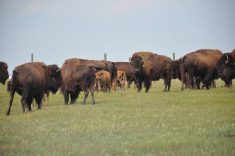Dr. Cheryl Waldner of the Western Veterinary College in Saskatoon has just completed a comprehensive survey of early calf diseases in Western Canada.
Surveys were distributed to veterinary clinics and randomly distributed to their clients.
This area had not been looked at for some time and interesting results were obtained reflecting the ever-changing dynamics of the cow-calf sector.
It is no surprise that the average number of cows per herd has increased over the years to 200 head.
Fourteen percent of herds treated more than 10 percent of their calves for scours, while five percent of the herds had problems with scours. This illustrates the adage that once you have one case there will likely be more.
Read Also

Defence investments could benefit agriculture
A bump in Canada’s NATO spending commitments could lead to infrastructure investments that would benefit rural areas
It is important to try to prevent the first case from developing and isolate it to prevent further spread if that fails.
Boosting calf immunity using colostrum is a major way to prevent scours from developing. Good nutrition and scours vaccination are the best ways to improve a cow’s colostrum.
Calves that do not receive adequate colostrum should be supplemented with a quality colostrum substitute.
Good scours vaccines are available that provide a broad spectrum of protection, but I was shocked to read in the survey that only 40 percent of producers vaccinate.
It’s one reason why many calves are still treated for scours and why clinics sell so much electrolyte in spring.
I would rather try to prevent than treat.
Producers who care for half the herds in the survey regard diarrhea, whether scours or coccidiosis, to be the most important disease they treat.
It is good to see many producers conscientiously using colostrum or colostrum supplements when necessary.
Calves in 70 percent of the herds were given colostrum supplementation if it was necessary. This may have been in only one calf but it shows producers are prepared to administer it and have it on hand.
The quality of commercial colostrum sources such as Headstart has improved over the years. The amount of immunoglobulin is indicated on the label.
Headstart is colostrum from dairies that vaccinate for scours because maximum protection is paramount.
Some producers milk out a heavy producing cow the first time as a way to have colostrum on hand.
The survey found only 1.9 percent of respondents used homemade recipes, boluses and milk replacers. I caution against these homemade efforts because they don’t provide as much protection as producers might think.
Education is still necessary when it comes to colostrum supplementation, but the majority of producers are getting the message.
Producers may also be able to prevent the first scours case from developing by providing colostrum supplementation to twin calves or calves on cows with mastitis or with little milk.
A little effort here may save lots of treatment headaches later on in the calving season.
The survey showed that scours is more likely to occur in early calving, whether because of increased stress from cold weather, close proximity to each other or being run through a calving barn.
Clostridial organisms are one cause of scours, so vaccinating with a clostridial vaccine after Jan. 1 greatly decreased incidence of the disease.
Vaccinating with a scours vaccine after Jan. 1, rather than in the fall or not at all, also lowered the risk of calves dying when they were younger than one month.
The colostral immunity will be high to both these vaccines.
Boostering cows with blackleg vaccine every year or two is becoming more acceptable in our area. It has many benefits, some of which we can’t explain.
Veterinarians generally believe electrolytes are the most important way to treat scours, followed by antibiotics, usually injectable, and anti-inflammatory drugs.
However, the reverse actually happens. Producers with scours are three times as likely to treat only with antibiotics than with electrolytes.
Most scours occur at three days or older, which means the disease is most likely viral and electrolytes will do them more good.
Most veterinarians also believe that because the gut is compromised, injectable antibiotic drugs that get into the bloodstream are more beneficial then boluses, which need to be digested and then absorbed.
The survey found that this is happening: twice as many calves are treated with injectable antibiotics.
Producers use lots of different concoctions, including homemade electrolyte solutions. Some have merit and others probably don’t. I like the commercial electrolyte products, which have been balanced and tested.
Pneumonia was the second most recognized neonatal problem identified in the survey, followed by navel infection.
Injections of selenium and vitamins A and D are still the most common treatments given to calves at birth.
More producers are calving later and on pasture, which is why 40 percent of producers follow these two procedures.
Long acting antibiotics are given at birth to 15 percent of the calves, probably as a protection against navel infection or pneumonia.














